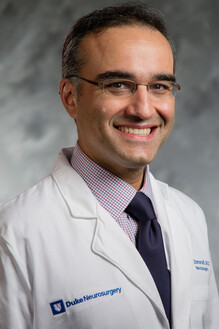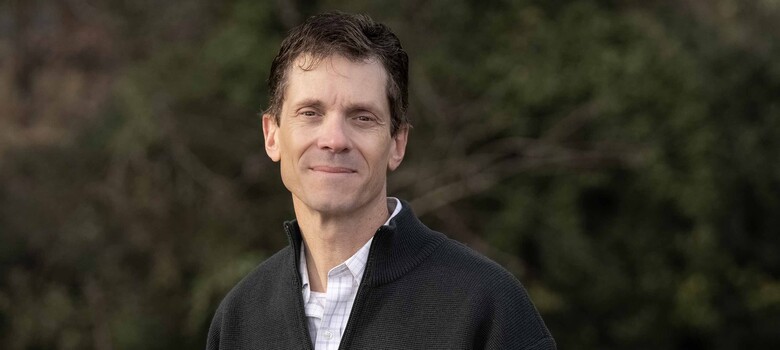Hearing Preserved After Surgery to Remove Large Acoustic Neuroma
Duke Offers Advanced Surgical Approach for Skull Base Tumor

Eliana Vera González smiles as her daughter embraces her at their home in Morrisville, NC.
In September 2023, Eliana Vera González was diagnosed with an acoustic neuroma, a non-cancerous skull base tumor that grows near the brain and inner ear. Because of its size and location, removing it could result in permanent function loss, including hearing loss. Duke surgeons used an advanced surgical technique to safely remove González’s tumor and preserve her hearing. Now González, 38, is thankful to be enjoying time with her family. “I spent a few months without being able to play with my seven-year-old daughter due to headaches and dizziness,” González said. “Today, thanks to God and Duke, we can do it."
Lingering Symptoms Become Emergent
A few years ago, in her home country of Venezuela, Eliana Vera González’s doctors suspected she had vertigo when she began experiencing dizziness, headaches, and hearing problems. Her symptoms worsened over time, and she fainted several times after arriving in the U.S. During a trip to Duke University Hospital’s emergency room, González learned a tumor was growing inside her skull and she needed surgery to remove it. Although González was scared, she found comfort in Catherine Lingo, RN, a Duke nurse navigator who shepherds people like Gonzalez through their treatment process.
“At the beginning I was really nervous,” said Gonzalez. “Fear makes you have a lot of doubts. But Catherine helped me stay calm.”
Acoustic Neuroma Threatens Hearing
González’s tumor was an acoustic neuroma, a benign tumor that grows near the nerves responsible for hearing and balance. At about three centimeters in size, the tumor was blocking cerebrospinal fluid passageways and causing a dangerous buildup of fluid, a condition called hydrocephalus. Duke doctors performed a procedure to relieve the pressure on González’s brain. Next, the tumor needed to be removed, but doing so could cause González to lose hearing on one side as well as permanent dizziness and facial nerve damage.
“Because of where acoustic neuromas grow, one of the biggest concerns with treatment is potential hearing loss,” said Duke neurotologist Cal Cunningham, MD. “There is a significant chance that the patient will lose all their hearing on the side with the tumor, no matter what treatment option they choose.”
Dr. Cunningham is one of several Duke otologists and neurotologists -- ear, nose, and throat doctors who specialize in difficult-to-treat and neurological-related ear problems like acoustic neuromas. Alongside specialized neurosurgeons, radiation oncologists, audiologists, physical therapists, and others, they work together to achieve the best-possible outcomes for people with rare, complex skull base tumors. “These conditions can have a huge impact on someone’s quality of life. Our goal is to try to preserve and or even restore their normal function so that they can get back to the life that they had before,” Cunningham said.
Surgical Technique Gives Hearing Preservation a Chance
Dr. Cunningham partnered with Duke neurosurgeon Ali Zomorodi, MD, to access González’s tumor through the bone behind her left ear. Although difficult with a tumor as large as González’s, this technique increased the chance of preserving her hearing and reduced the risk of damage to nearby facial nerves. After she woke up, González knew her doctors had accomplished their goal.
“The positive results were so amazing because it was very unlikely that I would be able to hear at all on my left side,” González said.
A New Normal After Treatment
Aside from a minor complication a few weeks after surgery, González recovered well and is grateful to feel better.
“I can do a lot of things that I couldn't do before,” González said. “I couldn't walk on my own because of the dizziness. I had forgotten what it felt like to walk looking straight ahead and not have to hold on to a wall or another person, or to turn around without getting confused or dizzy.”
Best of all, she can run, laugh, jump, and sing with her daughter. “It is amazing,” she said.




